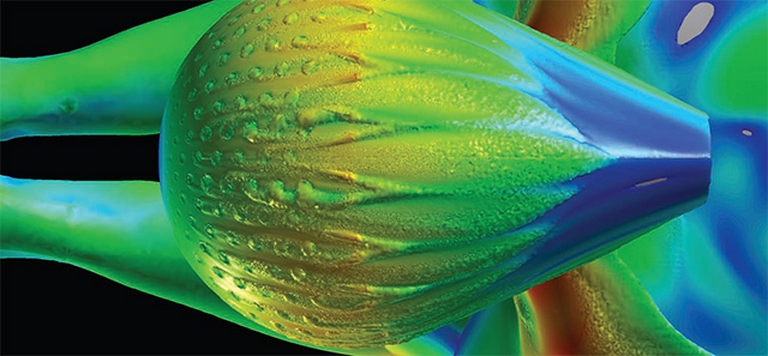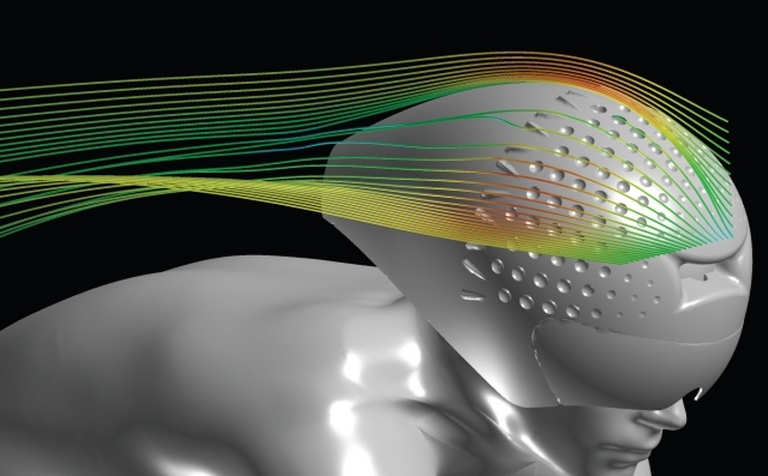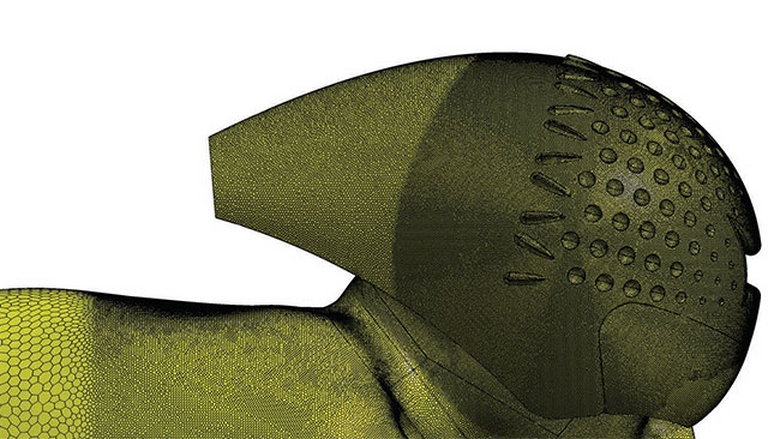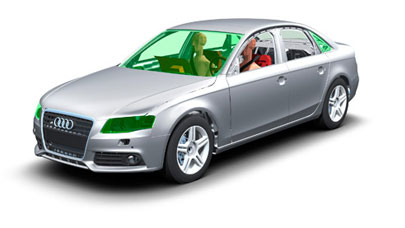Winning versions
Boosted by this initial success, the two partners undertook to design a new helmet, Vorttice. In analyzing Superleggera, many ideas were proposed for improvement, such as reducing the frontal area of the helmet, relocating the air intake position, adding air ducts within the helmet to improve air flow and cooling power, and finding ways to reduce the sensitivity of the helmet to angle of attack. A particular idea Lx Research & Development brought to the table was adding vortex generators to the helmet, common in other racing sports, which create turbulent flow across the back half of the helmet, forcing the boundary layer (the interface zone between the body and the fluid) to remain attached for longer and thereby minimizing drag. The two companies were able to make modifications daily to the helmet design, taking information from previous iterations to make small changes.

Fig. 3 – Turbulence visualization on the helmet. Note the turbulence at each of the vortex generators.
CFD analyses also highlighted significantly substandard airflow within Superleggera. This led to the decision to alter the location of the cooling channels air intake inside the helmet, which significantly improved its cooling efficiency. Other things that the two companies were able to do were to quickly analyze the helmet’s performance at speeds up to 60 km/h and to examine different angles of attack for the helmet, something difficult to reproduce in a wind tunnel because at this speed, a cyclist usually cannot hold his head still enough for accurate measurements to be taken.
Lx Research & Development ran a new helmet design every day (including weekends) for a month before the design was optimized to Louis Garneau’s satisfaction. The process produced a vastly superior helmet in a lot shorter period of time than the clay model method, not to mention the reduced cost of the process. In addition, Louis Garneau had vastly more data and information about their new helmet from the CFD analysis than they could have gathered from a wind tunnel test, giving them further insight into potential improvements in the future. After all this, it is hardly surprising that Vorttice became a global success. It was used by team Europcar for the last Tour de France, and also chosen by Mirinda Carfrae, the current Ironman triathlon world champion.
Behind the laboratory doors
Despite the complexity of the design, the final product’s CFD analysis uses only 10 million polyhedral cells in the volume mesh for both the helmet and the rider, which significantly reduces the needs in computing power. The re-envisioned process for the design of the helmet goes from 3D-CAD modeling, CFD/CAD iterations, rapid prototyping and a single wind tunnel test… to tooling for production. As mentioned above, Lx Research & Development started the new iteration of the design based simply on a new CAD model. They then wrapped it with the digital cyclist to remove any CAD impurities (using STAR-CCM+’s surface wrapping tool), remeshed and produced results in a single day, reusing only the physics characteristics for each run. These results were then returned to Louis Garneau engineers for analysis and further modifications.
This is a further illustration of the benefits of engineering simulation, compared to the “old-school” process. The gains achieved in technical performance, cost and time have also encouraged Louis Garneau to continue the partnership with Lx R&D. A successor to Vorttice is now being designed, on a brand-new digital engineering platform built around the CD-adapco tools. This may be important news for those of our readers tempted by sporting wagers…
Within a few hairs’ breadths…
Cycling is a sport in which every second really does count, and small aerodynamic advantages can be the difference between winning and losing the Tour de France. In 1989, Greg Lemond trailed French rider Laurent Fignon by 50 seconds prior to the final stage, a 24.5 km ITT. To most observers, this gap was insurmountable: Lemond had to ride each kilometer two seconds faster than Fignon, himself no mean time-trialist. On a warm Paris afternoon, Lemond, using an aerodynamically streamlined helmet and bicycle, beat Fignon, riding a conventional road bike, by 58 seconds, and won the Tour by just eight seconds. Subsequent analysis suggested that the drag on Fignon’s ponytail alone was enough to slow him down by the critical eight seconds, allowing Lemond’s name to be on the list of Tour winners forever.
More around this topic...
In the same section
© HPC Today 2024 - All rights reserved.
Thank you for reading HPC Today.

































